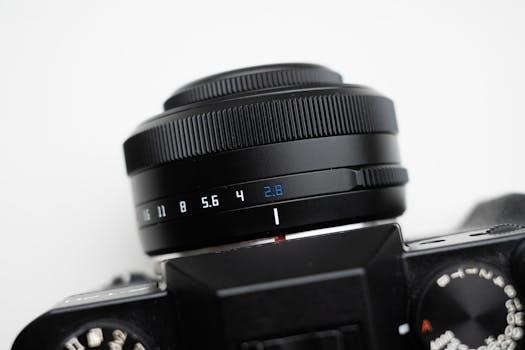Honeywell 7800 Series Manual⁚ An Overview
The Honeywell 7800 Series manual provides comprehensive instructions for the installation, operation, and maintenance of these advanced burner controls. It details safety features, programming procedures, and troubleshooting tips, essential for ensuring reliable and efficient performance.
The Honeywell 7800 Series represents a significant advancement in burner control technology, utilizing microprocessor-based architecture for enhanced safety, functionality, and features. Designed for automatically fired gas, oil, or combination fuel single-burner applications, the 7800 Series surpasses conventional controls in capability. These controls are suitable for various burner types with unlimited capacity, making them versatile for industrial use. Remote monitoring is enabled through the Thermal IQ Honeywell Connected Plant solution.
The series is programmed to deliver a superior level of safety and functional capabilities, exceeding traditional control systems. This includes advanced flame monitoring, expanded annunciation, and precise control over burner sequencing. The 7800 Series offers customized product solutions and is supported by technical expertise, ensuring successful implementation and operation in diverse industrial settings. Its modular design and compatibility with existing Honeywell flame detectors and amplifiers further enhance its adaptability and ease of integration.

Key Features and Capabilities
The Honeywell 7800 Series boasts several key features that enhance burner control functionality. These include microprocessor-based logic for precise and reliable operation, advanced flame detection algorithms for enhanced safety, and expanded annunciation capabilities for comprehensive system status monitoring. The series supports various fuel types, including gas, oil, and combination fuels, making it suitable for diverse applications.
The 7800 Series offers programmable burner sequencing, allowing customization of startup and shutdown procedures to optimize performance and safety. It provides extensive diagnostic information, facilitating troubleshooting and maintenance. Compatibility with a range of flame detectors and amplifiers allows flexibility in system design. Remote monitoring capabilities, enabled by the Thermal IQ Honeywell Connected Plant solution, provide real-time performance data and enhance operational efficiency. The 7800 Series also features valve proving options and supports Modbus, HART, and Profibus communications for seamless integration into existing control systems.

7800 Series Relay Modules (RM/EC7890)
The Honeywell 7800 Series includes RM/EC7890 relay modules, microprocessor-based controls for single burner applications using gas, oil, or combination fuels. These modules offer enhanced safety, functionality, and features beyond conventional controls.
RM7890A, B, C Functionality
The RM7890A, B, and C relay modules within the Honeywell 7800 Series offer distinct functionalities tailored to specific burner control requirements. These microprocessor-based modules are designed for automatically fired gas, oil, or combination fuel single burner systems, ensuring precise and reliable operation. The RM7890 series provides advanced safety features, exceeding the capabilities of conventional controls. These modules manage the burner sequence, monitor flame status, and provide system diagnostics.
Each variant – A, B, and C – offers a unique set of features. The RM7890A serves as a basic control module, while the RM7890B incorporates enhanced communication capabilities. The RM7890C provides expanded input/output options for more complex burner systems. These relay modules integrate seamlessly with other 7800 Series components, such as flame detectors and annunciators, creating a comprehensive burner management system.
The RM7890 modules support remote monitoring via Thermal IQ, Honeywell’s Connected Plant solution.
Replacing RA890F, G, H Protectorelay
The Honeywell 7800 Series RM/EC7890 relay modules are designed as direct replacements for the older RA890F, G, and H Protectorelay primary controls. This upgrade path allows users to modernize their burner management systems with minimal disruption, leveraging the advanced features and enhanced safety of the 7800 Series.
When replacing an RA890 Protectorelay, the RM/EC7890 module offers improved reliability, expanded diagnostics, and greater flexibility in burner control. The RM/EC7890 modules offer a microprocessor-based platform, providing more precise control over the burner sequence and flame monitoring. The upgrade involves rewiring the existing system to match the RM/EC7890 terminal configuration, ensuring compatibility with existing flame sensors and other components.
The 7800 series offers enhanced safety features, including flame failure response and limit switch monitoring. Transitioning to the RM/EC7890 ensures a safer and more efficient burner operation. The detailed instructions in the 7800 Series manual guide technicians through the replacement process.
Programming and Configuration
The Honeywell 7800 Series allows programming and configuration to adapt to different burner requirements. This involves setting parameters for timing, flame detection, and safety interlocks, ensuring optimal performance and safety.
Using S7800A1142 Programmer
The S7800A1142 programmer is essential for configuring and troubleshooting the Honeywell 7800 Series burner control systems. This device allows technicians to access and modify various operational parameters, including timing sequences, flame detection thresholds, and safety interlock settings. Proper use of the S7800A1142 ensures that the burner control system operates efficiently and safely.
The programmer facilitates tasks such as setting up valve proving sequences, adjusting pre-purge times, and configuring flame failure response. It also allows for diagnostic checks, providing valuable insights into system performance and potential issues. Technicians can use the S7800A1142 to monitor real-time data, such as flame signal strength and system status, aiding in troubleshooting and maintenance.
Detailed instructions on using the S7800A1142 programmer are available in the Honeywell 7800 Series manual, ensuring users can effectively manage and optimize their burner control systems. This programmer enhances the functionality and safety of automatically fired burners.
Flame Detection and Amplifiers
The Honeywell 7800 series incorporates advanced flame detection technology. Amplifiers like the R7847A and B are crucial for monitoring flame presence. These components ensure safe and reliable burner operation in various industrial applications.
R7847A, B Rectification Flame Amplifiers
The R7847A and R7847B are solid-state, plug-in rectification flame amplifiers designed for use with the Honeywell 7800 SERIES Relay Modules. These amplifiers respond to a rectified signal from a rectification-type flame detector, indicating the presence of flame. They are essential components in ensuring safe and reliable burner operation.
These amplifiers are compatible with various 7800 SERIES Relay Modules. The R7847A and B amplifiers provide a crucial safety function by quickly detecting flameouts and initiating appropriate safety shutdowns. Their solid-state design enhances reliability and longevity, reducing the need for frequent replacements.
Utilizing rectification principles, these amplifiers interpret the flame signal to confirm its presence. Proper installation and regular maintenance are critical for optimal performance and safety; Consult the Honeywell 7800 SERIES manual for detailed specifications and troubleshooting guidance to ensure proper functioning of the R7847A and B amplifiers.
Compatibility with 7800 Series Flame Detectors
The Honeywell 7800 Series is designed for seamless integration with a range of flame detectors, ensuring reliable flame supervision in burner control systems. These flame detectors are specifically engineered to work with the 7800 Series Relay Modules and flame amplifiers, providing a comprehensive flame safeguard solution.
The compatibility extends to various types of flame detection technologies, including ultraviolet (UV) and rectification flame detectors. This allows for flexibility in selecting the appropriate flame detector based on the specific application requirements. Ensuring correct pairing of flame detectors and amplifiers is crucial for optimal system performance and safety.
The Honeywell 7800 Series manual provides detailed information on compatible flame detector models and their proper installation and configuration. Adhering to these guidelines ensures reliable flame detection and minimizes the risk of false alarms or undetected flame failures. Regular testing and maintenance are essential to confirm the continued compatibility and functionality of the flame detection system.

Expanded Annunciation with S7830
The S7830 Expanded Annunciator is an enhancement module designed for use with the Honeywell 7800 SERIES Relay Modules, providing advanced monitoring capabilities for burner control systems. This microprocessor-based device monitors the status of a series string of limit, control, and interlock contacts, crucial for commercial and industrial burner applications.
The S7830 significantly improves system diagnostics by offering detailed annunciation of alarm conditions and system status. This expanded annunciation allows operators to quickly identify the cause of a shutdown or fault, reducing downtime and improving overall system efficiency. The module integrates seamlessly with existing 7800 SERIES Relay Modules, providing a cost-effective way to upgrade annunciation capabilities.
Its design facilitates easy installation and configuration, ensuring compatibility with existing burner control systems. The S7830’s comprehensive monitoring capabilities enhance safety and operational awareness, making it an invaluable addition to any 7800 SERIES-based burner control system.

Applications and Industries
The Honeywell 7800 Series burner control systems find extensive application across a diverse range of industries, owing to their reliability, safety features, and advanced control capabilities. These systems are particularly well-suited for industrial ovens, providing precise temperature control and efficient burner management, essential for processes like heat treating, drying, and curing.
In the oil and gas sector, the 7800 Series is utilized in fired heaters, boilers, and other combustion equipment, ensuring safe and reliable operation in demanding environments. The power generation industry also benefits from these controls, employing them in utility boilers and cogeneration systems to optimize combustion efficiency and reduce emissions.
Furthermore, the chemical processing, manufacturing, and wastewater treatment industries leverage the 7800 Series for various heating applications, enhancing process control and ensuring compliance with stringent safety standards. The versatility and adaptability of the 7800 Series make it a preferred choice for industries seeking robust and dependable burner control solutions.
Troubleshooting and Maintenance
Maintaining the Honeywell 7800 Series burner control system is crucial for ensuring its continued reliable operation and preventing unexpected downtime. Regular inspections should be conducted to check for any signs of wear, damage, or loose connections. It is essential to verify the proper functioning of flame detectors and amplifiers, as these components are vital for safe burner operation.
Troubleshooting common issues often involves checking the system’s diagnostic messages and error codes, which can provide valuable insights into the nature of the problem. The manual provides detailed guidance on interpreting these messages and implementing appropriate corrective actions. Replacement of components, such as relay modules or flame sensors, should be performed by qualified personnel following the manufacturer’s instructions.
Periodic cleaning of the control unit and associated components can help prevent the buildup of dust and debris, which can affect performance. Keeping detailed records of maintenance activities and any encountered issues can aid in future troubleshooting and ensure the long-term reliability of the 7800 Series system.
Comments